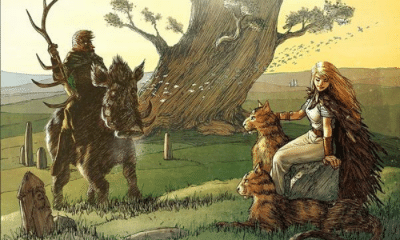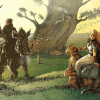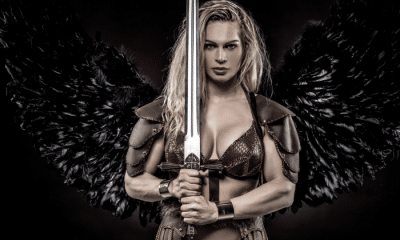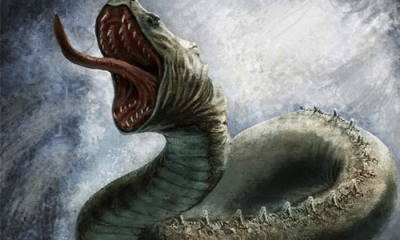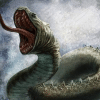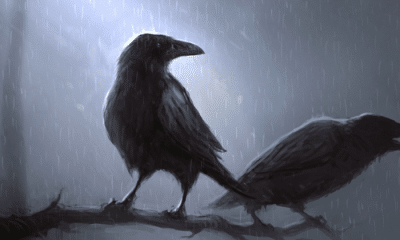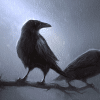Norse
What Was Nidhogg in Norse Mythology?
Nidhogg was a terrible snake that ate away at the roots of the World Tree, but what was the meaning behind this monstrous serpent?
In Norse cosmology, the Nine Worlds were supported by Yggdrasil, the World Tree.
Although Yggdrasil held the entirety of creation in its branches, it was still vulnerable.
In the frozen realm of Niflheim, the serpent Nidhogg chewed on one of Yggdrasil’s roots. His venom and the decay of Niflheim’s dead slowly poisoned the World Tree, threatening the foundation of the universe.
The Norse believed that one day Nidhogg would kill Yggdrasil’s root, weakening the World Tree enough to release the dead into the world of the living as one of the armies of Ragnarök.
Nidhogg was more than just a monstrous serpent, however. It was also a reference to a threat felt more closely by the people of the Viking Age, the corruption and decline of their own culture.
Nidhogg and the Roots of the World Tree
In Norse cosmology, Nidhogg was one of many creatures who lived in Yggdrasil, the World Tree.
Yggrasil was a great ash tree that connected and supported the Nine Worlds of the Norse universe. It had three large roots that each fed from a well in one of the Nine Worlds.
While most beings lived in one of the Nine Worlds, some made their home in the roots and branches of Yggdrasil itself.
Nidhogg, transliterated from Old Norse as Níðhöggr, lived at the base of one of Yggdrasil’s roots.
It was usually described as a great serpent who continuously gnawed at the tree’s root, weakening it and the World Tree as a whole.
The root that Nidhogg was usually said to live near was placed over Niflheim. The world of primordial ice and cold had become the home of Hel and her legions of the dead.
In addition to chewing on Yggdrasil’s root, Niddhogg was also said to feast on the souls of the dead in Niflheim. Hel’s realm was often said to contain the souls of those shunned from the halls of the gods for their misdeeds in life, and the serpent chewed on their rotting corpses.
The combination of this decay and the snake’s own venom was hazardous to Yggdrasil. While the World Tree was strong enough to support the Nine Worlds, Nidhogg cause rot to slowly creep into one of its three roots.
While Nidhogg lived near one of Yggdrasil’s roots, the tree’s canopy was home to a great eagle. The unnamed eagle had a hawk called Veðrfölnir perched on its forehead.
Nidhogg and the eagle were enemies but never left their respective places to engage one another face to face. In fact, some images of Nidhogg imply that he was pinned down by Yggdrasil’s roots so that he could not travel along the World Tree and cause further problems.
Instead, a squirrel named Ratatoskr ran back and forth between the two. Ratatoskr scurried up and down Yggdrasil’s trunk to convey insults between the wyrm and the eagle that lived on opposite ends of the World Tree.
Nidhogg is mentioned in relatively few ancient sources, but one poem implies that he is one of the many portents of Ragnarök.
The common interpretation of this poem is that Nidhogg will one day cause enough damage to Yggdrasil’s root that it will break, possibly weakening the entire structure of the World Tree. When that happens, the serpent will be able to leave Niflheim.
Nighogg will go to Midgard, the world of men. He will be closely followed by Hel’s army of the dead who will leave Niflheim after him.
The dead will face off against Odin’s warriors from Valhalla, led by Hel and Loki. While they will win their fight, they will be entirely destroyed in the process.
My Modern Interpretation
The name Níðhöggr contains a possible explanation for the appearance of the serpent at the base of the World Tree.
In Viking Age culture, the word níð referred to a specific social stigma. It meant the loss of status and honor, resulting in a person being labeled as a villain and cast away from society.
Norse culture highly valued both personal honor and the bonds of community and family, so níð represented a complete loss of one’s place in that society.
The name Níðhöggr, or Nidhogg, can therefore be translated as a monster of níð. It was the embodiment of the wretched, villainous state of those who had lost their place in society through their own actions.
Hel’s realm in Niflheim was itself a place of níð. While some said that most souls ended up there, it was more commonly viewed as a place of punishment for oathbreakers, murderers, and others who had forfeited their place in the halls of the gods.
Nidhogg was an extra form of punishment for these villains. In addition to the cold and gloom of Niflheim, the damned risked being eating by the embodiment of their own sins.
With this interpretation, Nidhogg’s gradual poisoning of Yggdrasil is also a reflection of the loss of honor in Norse society.
The corruption of Yggdrasil was a direct result of corruption within society. Níð, as represented by both the monstrous form of Nidhogg and the decaying corpses of Hel’s prisoners, was the poison that was slowly killing the World Tree.
The unusual duo of the eagle and hawk at the top of Yggdrasil has been compared by some historians to Odin and his ravens. The hawk, it is assumed, brings news and knowledge to the eagle.
If Nidhogg can be tied to the concept of lost status and rejection from society, his enmity toward the eagle may be symbolic of hatred for the knowledge and wisdom represented by these birds.
In this interpretation, Ragnarök can be interpreted as the end of Norse culture rather than the world as a whole.
Nidhogg, the monster of níð, will one day allow all of society’s villains to be released. Although Odin will have gathered an army of valiant and honorable warriors at Valhalla, they will be outnumbered and fall to the dead of Hel.
The implication is that Norse society as a whole will someday be overcome by níð. While some honorable men will try to maintain the old ways, corruption and dishonor will eventually lead to the end of civilized life.
In Summary
Nidhogg was one of the creatures that lived in Yggdrasil, the World Tree, in Norse mythology. A great venomous serpent, he chewed on the root of Yggdrasil that lay over the ice realm of Niflheim.
He also feated on the decaying bodies of the dead in Hel’s realm. The combination of decay and poison slowly weakened the root of the great World Tree.
It was believed that Nidhogg and the dead would both break free of Niflheim at the beginning of Ragnarök, presumably by weakening Yggdrasil’s root until it could no longer hold them.
Nidhogg was more than just a fantastical beast, however. He was also the monstrous embodiment to a concept that the Norse felt represented a very real threat to their world.
The serpent’s name contains the word níð, which referred to the Norse concept of the loss of social status. It was applied to those who lost their honor and place in society through crimes such as adultery, murder, and oathbreaking.
These same people were sent to Hel’s realm in Niflheim after death. Nidhogg both embodied their shame and punished them after death.
In this interpretation, níð itself can be thought of as the real threat of Ragnarök. Dishonorable villains threatened to one day overthrow Norse society by outnumbering and weakening its concepts of honor, law, and social cohesion.


